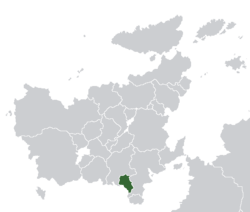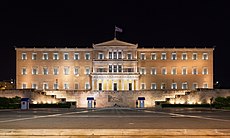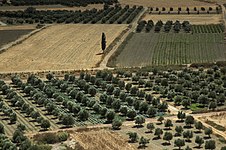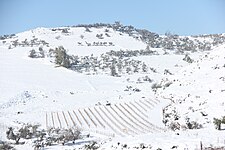Piraea
This article is incomplete because it is pending further input from participants, or it is a work-in-progress by one author. Please comment on this article's talk page to share your input, comments and questions. Note: To contribute to this article, you may need to seek help from the author(s) of this page. |
Piraean Republic Πειραιηκή Δημοκρατία Pireikí Dimokratía (Piraese) | |
|---|---|
Anthem: "Ύμνος προς την Ελευθερίαν" "The Homeland" | |
 Piraea (dark green) in Euclea (dark grey). | |
| Capital and largest city | |
| Official languages | Piraese |
| Recognised regional languages | Novalian |
| Ethnic groups (2015) | |
| Demonym(s) | Piraean, Piraese |
| Government | Unitary parliamentary republic |
| Pavlos Kassapidis Stella Davakis Stefanos Xanthos | |
• Premier | Maria Theopeftatou |
| Legislature | Piraean Senate |
| Establishment | |
• 1st Piraean Empire | 639 - 884 |
• 2nd Piraean Empire | 1012 - 1368 |
• Grand Duchy of Alikianos | 1729 |
• Kingdom of the Piraese | 1857 |
• First Republic | 1947 |
• Second Republic | 1948 |
• Third Republic | 1979 |
| Population | |
• 2019 estimate | |
• 2017 census | 7,484,889 |
• Density | 86/km2 (222.7/sq mi) |
| GDP (PPP) | 2019 estimate |
• Total | $207.062 billion |
• Per capita | $27,664 |
| GDP (nominal) | 2019 estimate |
• Total | $113.299 billion |
• Per capita | $15,137 |
| Gini (2020) | low |
| HDI (2020) | very high |
| Currency | Drachma (₯) (PRD) |
| Time zone | Euclean Central Time |
| Date format | dd-mm-yy |
| Driving side | right |
| Calling code | +42 |
| Internet TLD | .pr |
Piraea (Pireás: Πειραεάς, tr. Peiraeás), officially the Piraean Republic (Pireás: Πειραεηκή Δημοκρατία, tr. Piraeikí Dimokratía) is a country in Southern Euclea located along the Acheloian Sea. It borders Amathia to the north, Etruria to the east and the disputed territory of Tarpeia to the south. Piraea has a population of approximately 7.4 million, which are concentrated in urban areas along the coast. Alikianos is the capital and largest city of the country, and is followed by Kissamos, Hersonissos and Tylissos.
Piraea is recognised as one of the most civilisations in Euclea. Its presence along the Acheloian and Solarian Seas as well as in the Aurean Straits is well documented in numerous texts that highlight the greatest extent of the Piraese city-states along both sides of the strait. This form of political organisation was crucial for Piraea in the development of the first forms of democracy and innumerable mathematical advances. However, between the year 300 and 200 BCE, city-states will progressively fall under Solarian influence, with the fall of Alikianos marking the end of the period. The previous developments that characterised Piraese city-states were later used as inspiration during the Solarian period in a moment of massive advances in philosophy and arts. The collapse of Solaria in hands of Marolevic tribes pushed Piraea to form the First Piraean Empire, which collapsed centuries later during the invasion of the Tagames. Piraese control over the territory was re-established under the Second Piraean Empire, although short living as internal turmoil and a lack of national identity took it to the collapse, initiating a period of foreign control of Piraea by Amathian, Novelian and Poveglian authorities.
In 1820, under the control of the Kingdom of Vespasia, ethnic Pirese joined in what is known as the October Uprising, which led to a War of Independence that lasted five years and proved effective in building a national narrative for Piraese identity. The revolution will last until 1925, when diplomatic intervention of Euclean powers concluded with the effective establishment of the Kingdom of Piraea. At the burst of the Great War, Piraea joined the Entente, declaring its support to Gaullica and declaring war on Etruria; however, the country got immersed in a series of internal conflicts that questioned the continuity of the monarchy. The defeat of the Entente and Piraea at the end of the war took the Kingdom to hand in Tarpeia to Etruria; this will take the popularity of the monarchy to the lowest and mark the start of a civil war that concluded a year later with the abdication and exile of the Royal Family. During the following years, Piraea will be under the control of an authoritarian military junta of far-right characteristics until 1979, when students and workers' massive protests took the government to pursue a consolidation of the regime through the vote of a plebiscite; the negative of the population concluded with the celebration of the first democratic elections and the start of a transition period.
Today, Piraea is a unitary parliamentary republic and developed country with a high standard of living. It is led by a collective Presidency composed by three members and a Premier, who acts as Head of Government. The economy is dominated by the service and industrial sectors, and counts with large contributions from the agriculture sector, in which Piraea is a leading exporter of cheese, olive oil and wines. The state provides social security and universal health care systems in addition to tuition-free primary and secondary education; corruption still plays a role in politics and has downgraded Piraea's status in numerous rankings. The country is a member of the Community of Nations, International Council for Democracy, Euclean Defence Treaty Organisation, Global Institute for Fiscal Affairs, and the International Trade Organisation; as of 2021, the country has formalised its intentions to be a member state of the Euclean Community and is a recognised candidate.
Etymology
The name Piraea comes from the Ancient Piraese name Πειραιεύς (Peiraieús), which roughly means 'the place over the passage'. Over time the Ancient Piraese evolved into the modern Πειραιάς (Piraeus). Piraea is the embricized version of Piraeus.
History
Classical period
Solarian rule (300 BCE-500 AD)
Middle Ages and Empires (500 AD-1368)
Duchy of Alikianos and Kingdom of Piraea (1729-1857)
Industrialisation and Great War (20th century)
First Republic (1947-1948)
Military rule (1948-1979)
Third Republic and contemporary history (1979-present)
Geography
Politics and government
Piraea is a unitary parliamentary republic, which is constituted in the 1979 Constitution of the Third Republic. Exective power is divided between the Head of State and a Head of Government; the first is consolidated in the collective figure of the Presidency, while the second, consists in the figure of Premier, who is appointed by the Chairperson of the Presidency after gaining the confidence of the legislature. As a secular nation, the constitution recognises the preponderant position of the Episemialist Church but grants the state protection of religious freedom; Piraea's constitution recognises important civil and Human Rights, freedom of speech and expression, and the adoption of a social state.

The members of the Presidency are elected via universal suffrage and seats allocated between two for the party with the most votes and one for the second; as members of the Presidency are conceived as independent and non-partisans, Piraese political tradition requires them to resign to their places in their respective political parties. The three members serve for six years and their positions can be renewed one more time. While there is no higher position than the Presidency and the three members count with equal power, a ceremonial chairperson title for two years by each member. The figure of Head of Government, impersonated in the Premier, is appointed by the Presidency after gaining the confidence of the Senate; usually, nominees for the Premiership are party leaders of the most voted parties after general elections take place. The figure of Premier is who usually leads daily politics in Piraea as appoints members of the cabinet.
Foreign relations
Administrative divisions
Military
Law enforcement
Economy
Labour market
Transport and infrastructure
Energy
Demographics
Religion
Largest cities
| Rank | Name | Province | Pop. | ||||||
|---|---|---|---|---|---|---|---|---|---|
 Alikianos  Kissamos |
1 | Alikianos | Souda Riviera | 1,380,508 |  Hersonissos  Tylissos | ||||
| 2 | Kissamos | Souda Riviera | 324,676 | ||||||
| 3 | Hersonissos | Sitia | 267,121 | ||||||
| 4 | Tylissos | Souda Riviera | 144,046 | ||||||
| 5 | Voula | Foinikas | 120,833 | ||||||
| 6 | Rouvas | Sitia | 96,157 | ||||||
| 7 | Gorgolainis | Foinikas | 82,921 | ||||||
| 8 | [[]] | [[]] | |||||||
| 9 | [[]] | [[]] | |||||||
| 10 | [[]] | [[]] | |||||||








